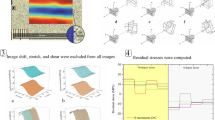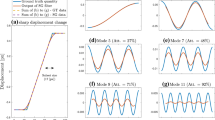Abstract
Digital image correlation (DIC) is a surface deformation measurement technique for which accuracy and precision are sensitive to image quality. This work presents cross polarization, the use of orthogonal linear polarizers on light source(s) and camera(s), as an effective method for improving optical DIC measurements. The benefits of cross polarization are characterized through quantitative and statistical comparisons from two experiments: rigid body translation of a flat sample and uniaxial tension of a superelastic shape-memory alloy (SMA). In both experiments, cross polarization eliminated saturated pixels that degrade DIC measurements, and increased image contrast, which enabled higher spatial precision by using smaller subsets. Subset sizes are usually optimized for correlation confidence interval (typically with subsets of 21×21 px or larger), but can be decreased to achieve the highest possible spatial precision at the expense of increased correlation confidence intervals. Smaller subset sizes (such as 9×9 px) require better images to maintain correlation within error thresholds. By comparing DIC results from a uniaxial SMA tension test with unpolarized and cross-polarized images, we show that for 9×9 px subsets, the loss of valid DIC data points was reduced almost ten-fold with cross polarization. The only disadvantage we see to cross polarization is the decrease in specimen illumination due to transmission losses through the polarizers, which can easily be accommodated with sufficiently intense light sources. With the installation of relatively inexpensive linear polarizing filters, an optimum optical DIC setup can provide even better DIC measurements by delivering images without saturated pixels and with higher contrast for increased DIC spatial precision.

















Similar content being viewed by others
Notes
We have chosen “3-D DIC” to describe our DIC measurements with three dimensions of displacement. While 3-D DIC does provide all three displacements, it is still a surface measurement that only provides in-plane gradients of displacement (thus, four components of the deformation gradients, or equivalently three strain components and one rotation). It should not be confused with volumetric DIC (DVC), which can provide the full 3-D deformation gradient (nine components, or six strain components and three rotations).
The terminology is unfortunate in this context. In the optics community, “specular” reflections are defined as those reflections that maintain their polarity. This should not be confused with the “speckle” DIC pattern, which is defined as a random (non-periodic), black-white pattern of dots.
Of course, cross polarization could adversely affect an under-illuminated setup, but that is easily avoided.
Blooming occurs in imaging when fringes extend beyond a bright feature into a dark feature.
References
Peters W, Ranson W, Sutton M, Chu T, Anderson J (1983) Application of digital correlation methods to rigid body mechanics, Vol 22
Sutton M, Mingqi C, Peters W, Chao Y, McNeill S (1986) Application of an optimized digital correlation method to planar deformation analysis. Image Vis Comput 4 (3):143–150
Bay B, Smith T, Fyhrie D, Saad M (1999) Digital volume correlation: Three-dimensional strain mapping using X-ray tomography. Exp Mech 39(3):217–226
Franck C, Hong S, Maskarinec S, Tirrell D, Ravichandran G (2007) Three-dimensional full-field measurements of large deformations in soft materials using confocal microscopy and digital volume correlation. Exp Mech 47(3):427–438
Reu P (2014) All about Speckles: Aliasing. Exp Tech 38:1–3
Sutton M, Orteu J, Schreier H (2009) Image correlation for shape, motion, and deformation measurements. Springer , New York
Reu P (2014) All about speckles : Speckle Size Measurement. Exp Tech 44(11):4–5
Kammers A, Daly S (2013) Self-assembled nanoparticle surface patterning for improved digital image correlation in a scanning electron microscope. Exp Mech 53(8):1333–1341
Reedlunn B, Daly S, Hector Jr L, Zavattieri P, Shaw J (2013) Tips and tricks for characterizing shape memory alloy wire: part 5 – full-field strain measurement by digital image correlation. Exp Tech 37(3):62–78
Reu P (2014) Speckles and their relationship to the digital camera. Exp Tech 38(4):1–2
Hild F, Roux S (2012) Comparison of local and global approaches to digital image correlation. Exp Mech 52(9):1503–1519
Reu P (2015) All about Speckles: Contrast. Exp Tech 51(4):1–2
Kwak J (2008) Digital image correlation (DIC) methods for small scale measurement. Master’s thesis, Mechanical Engineering, State University of New York at Binghamton
Adams A (1948) Basic photo one: camera and lens
Allphin W (1959) Primer of lamps and lighting
Apolinar E, Rowe W (1980) Examination of human fingernail ridges by means of polarized light. J Forensic Sci 25 (1):154–161
Robertson A, Toumba K (1999) Cross-polarized photography in the study of enamel defects in dental paediatrics. J Audiov Media Med 22(2):63–70
Kawara T, Obazawa H, 1980 A new method for retroillumination photography of cataractous lens opacities. Am J Ophthalmol 90(2):186–189
Anderson R (1991) Polarized light examination and photography of the skin. Arch Dermatol 127(7):1000–1005
Cooper M, Skaggs M, Reu P (2015) High-speed stereomicroscope digital image correlation of rupture disc behavior. Society of Experimental Mechanics 2015 annual conference
LePage W, Shaw J, Daly S (2015) Thermomechanical characterization of shape memory alloy mode I fracture behavior. Society of Experimental Mechanics 2015 annual conference
Hanrahan P, Krueger W (1993) Reflection from layered surfaces due to subsurface scattering. In: Proceedings of the 20th annual conference on Computer graphics and interactive techniques, 165–174, ACM
Reu P (2015) Points on paint. Exp Tech 39:1–2
Pan B, Lu Z, Xie H (2010) Mean intensity gradient: An effective global parameter for quality assessment of the speckle patterns used in digital image correlation. Opt Lasers Eng 48 (4):469–477
Prewitt J (1970) Object enhancement and extraction. Picture processing and Psychopictorics 10(1):15–19
Kim K, Daly S (2010) Martensite strain memory in the shape memory alloy nickel-titanium under mechanical cycling. Exp Mech 51(4):641–652
Kim K, Daly S (2013) The effect of texture on stress-induced martensite formation in nickel–titanium. Smart Mater Struct 22(7):075012
Woodward C (1851) A familiar introduction to the study of polarized light
Acknowledgments
We gratefully acknowledge financial support from the National Science Foundation (CAREER Award, CMMI-1251891) and the Department of Defense (NDSEG Fellowship).
Author information
Authors and Affiliations
Corresponding author
Rights and permissions
About this article
Cite this article
LePage, W.S., Daly, S.H. & Shaw, J.A. Cross Polarization for Improved Digital Image Correlation. Exp Mech 56, 969–985 (2016). https://doi.org/10.1007/s11340-016-0129-2
Received:
Accepted:
Published:
Issue Date:
DOI: https://doi.org/10.1007/s11340-016-0129-2




